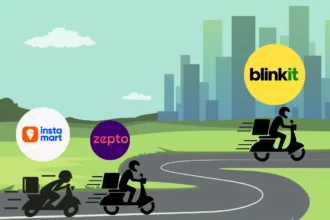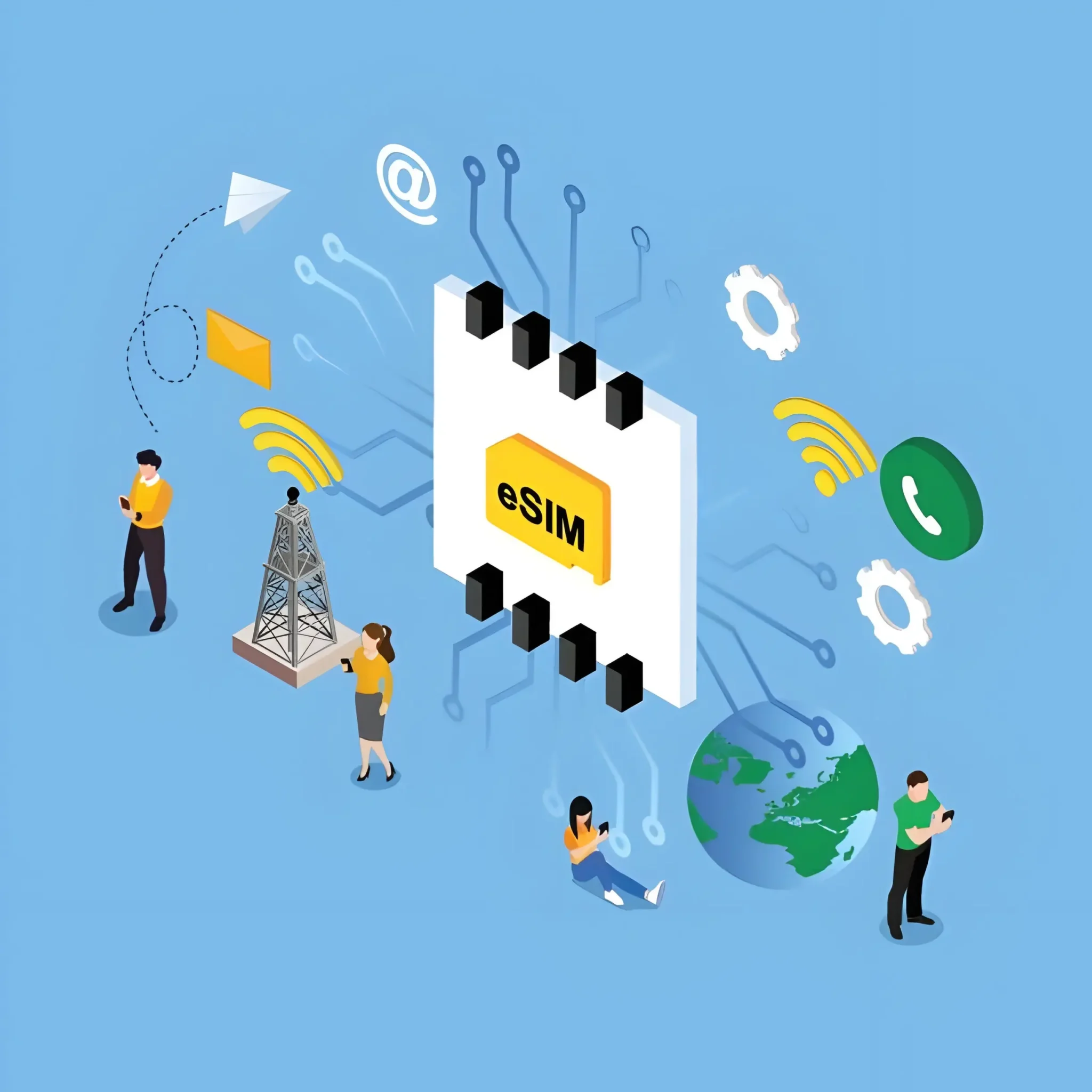Estimated Reading Time: 26-30 minutes ( 5,285 words)
Introduction
Imagine landing in Paris after a long-haul flight, turning off airplane mode, and watching your phone instantly connect to high-speed data — no queues at airport SIM counters, no confusing passport verification, and no surprise ₹8,000+ roaming bills waiting for you back home. For millions of global tourists, this scenario is quickly becoming the new normal. Thanks to eSIM technology, travelers no longer need to juggle tiny plastic SIM cards or depend on unreliable airport Wi-Fi just to book a taxi or message their family. The shift is especially meaningful for Indian tourists, who often face high international roaming costs from domestic carriers and limited prepaid SIM availability abroad.
What was once a niche feature limited to premium smartphones is now becoming a mainstream travel essential. As digital borders shrink and international travel rebounds, eSIM adoption is exploding across Asia, Europe, and North America. Travelers are choosing eSIMs for convenience, flexibility, safety, and — most importantly — cost savings. Instead of paying roaming fees of ₹999/day or ₹2,999/week from Indian telcos, travelers can now activate regional or country-specific eSIM plans instantly at a fraction of the price. This shift is reshaping the global travel-tech ecosystem, empowering tourists to stay connected from the second they land.
In this post, we’ll break down why eSIMs are rapidly becoming the preferred connectivity solution for modern tourists. You’ll learn how the technology works, the latest global and India-first market trends, cost comparisons vs. physical SIMs & traditional roaming, and step-by-step instructions to activate an eSIM on major devices. We’ll also cover safety tips, top eSIM providers, and practical recommendations for business travelers, solo female travelers, digital nomads, and families. Whether you’re planning your first international trip or travel frequently for work, this guide will help you make smarter connectivity decisions and avoid unnecessary costs — while staying online 24/7, anywhere in the world.

What Is an eSIM?
An eSIM (embedded SIM) is a next-generation digital SIM technology built directly into your device — whether it’s a smartphone, smartwatch, tablet, laptop, or even modern connected cars. Unlike a traditional plastic SIM card that you physically insert and remove, an eSIM is soldered onto the device’s motherboard. This means your phone can store and switch between multiple mobile network profiles digitally, without needing any physical card swaps.
At its core, an eSIM works like a virtual replacement for the physical SIM. Instead of visiting a store, showing ID, and inserting a card, you simply scan a QR code, tap a link, or download a profile through an app. In seconds, your device is connected to a mobile network anywhere in the world. This remote provisioning is enabled by GSMA’s eUICC technology, which ensures global interoperability and security standards across carriers.
Because of this embedded and programmable nature, eSIMs offer far greater flexibility than conventional SIMs:
- You can switch networks instantly, useful for comparing prices or changing countries.
- You can store multiple plans (work, travel, personal) and toggle between them.
- There’s no risk of losing or damaging a SIM card while traveling.
- Activation is much faster and completely online.
For tourists, digital nomads, and frequent flyers, eSIMs eliminate the hassles of physical SIM hunting, roaming charges, and airport queues — making international connectivity smooth, fast, and cost-efficient.
Why eSIMs Are Especially Useful for Tourists
eSIMs have quickly become one of the most important travel technologies because they eliminate the major pain points tourists face: high roaming bills, connectivity gaps, and the hassle of physical SIM cards. Below is a deeper look at why eSIMs are transforming international travel — especially for Indian and global tourists.
A) Cost Savings vs Traditional Roaming
1. Cheaper per GB than international roaming
Traditional roaming charges from major carriers (Airtel, Jio, Vi, AT&T, Vodafone, etc.) often range between ₹999–₹3,999 per week for limited data. In contrast, travel eSIM plans frequently cost 60–85% less per GB, depending on the destination.
For example:
- Airtel International Roaming (Europe): ~₹799/day for just 500MB
- Travel eSIM (Europe): ~₹1,499 for 10–20GB, valid for 30 days
Industry research from GSMA Intelligence shows that travel eSIM plans provide far more competitive data rates, especially in high-roaming-cost destinations like USA, UK, EU, Japan, and Middle East.
2. Falling prices due to rising market competition
The global travel eSIM market has grown sharply due to increasing post-pandemic travel, leading to heightened competition among providers such as Airalo, Nomad, Holafly, GigSky, Dent, and Ubigi. This competition is driving prices down each year, making eSIMs more affordable for everyday tourists.
According to market analytics firms, the travel eSIM segment has grown double digits annually, pushing providers to offer:
- Bigger data bundles
- Longer validity
- Lower per-GB rates
- Multi-region packs (Asia, Europe, Middle East, Global)
3. Rapid revenue growth reflects mainstream adoption
Business Research Insights and other global reports indicate that the travel eSIM market is projected to grow at a CAGR of 12–15% through 2030. This aligns with the increase in international travel and the broader shift toward digital connectivity solutions.
In short:
eSIMs are becoming the standard choice because they deliver more data for less money — with predictable pricing and no hidden roaming charges.
B) Seamless Connectivity
1. No more physical SIM swaps
One of the biggest frustrations for travelers is landing in a new country and scrambling to find a SIM card booth. With eSIMs, you bypass all of that.
You can:
- Buy your plan before leaving your home country
- Activate it by scanning a QR code or tapping a link
- Go online instantly when your plane lands
No queues. No paperwork. No fiddling with SIM ejector pins.
2. Use home carrier + travel data simultaneously
Most eSIM-compatible devices allow dual profiles:
- eSIM slot → Travel plan
- Physical SIM slot → Home SIM
This means you can still receive OTPs, bank messages, and calls on your home number while using cheaper eSIM data abroad.
3. Instant configuration, top-ups, and plan switching
With eSIMs, topping up or switching plans takes seconds — just open the app and activate another profile.
This is especially useful for:
- Multi-country Europe trips
- Layovers
- Long-term stays
- Digital nomads working remotely
You never need to visit a store or wait for physical delivery.
C) Multiple Profiles & Flexibility
1. Store several SIM profiles on one device
Your phone can store multiple eSIM profiles, letting you easily switch between:
- Personal number
- Work number
- International travel plans
- Local country plan
- Regional or global eSIM packages
This is ideal for travelers managing multiple countries or data needs.
2. Perfect for digital nomads and frequent flyers
Digital workers and business travelers often cross borders every week. eSIMs allow them to:
- Stay reachable
- Maintain stable data access
- Avoid roaming shocks
- Manage their connectivity through apps
Some eSIM providers support global plans covering 100+ countries, which are perfect for remote workers.
3. Pause/resume features save money
Many eSIM providers allow you to pause your plan, which is impossible with physical SIMs.
Examples:
- Pause your Asia plan while in Australia
- Pause your Europe plan when you return to India
- Resume the same data when you travel again
This gives you more control and prevents unused data loss.
D) Eco-Friendliness
1. Reduced plastic waste worldwide
Every physical SIM card generates:
- Plastic
- Packaging
- Chip manufacturing waste
- Transportation emissions
With millions of SIMs sold each month, this creates a significant environmental footprint.
eSIMs eliminate plastic production entirely.
2. Lower logistical and carbon footprint
Because eSIM provisioning is fully digital, it removes:
- Shipping
- Distribution
- Airport kiosk stock
- Retail packaging waste
This makes eSIMs one of the greenest digital innovations in telecom, aligning with sustainability goals across India, Europe, and global telecom operators.
3. Market Trends & Adoption (Global + India)
Global Adoption & Forecast
- According to GSMA, eSIM penetration for smartphones, tablets, and wearables is expected to reach 76% by 2030. GSMA+1
- The global eSIM-for-travel market was valued at USD 1.6 billion in 2025, and is projected to reach USD 4.07 billion by 2035 (CAGR ~9.8%). Business Research Insights
- As per Business Research Insights, the broader eSIM global market is projected to grow to USD ~5.96 billion by 2035 (~24.5% CAGR). Business Research Insights
- Device shipments with eSIM are surging: over 500 million units shipped in 2024. Mobilise Global
India Market Dynamics
- The India eSIM market was ~USD 388.96 million in 2024, and is projected to hit USD 1,459.82 million by 2033 (CAGR ~15.8%). IMARC Group+1
- But adoption is still catching up: only 10-15% of smartphones sold in India supported eSIM as of late 2023. The Economic Times
- Regulatory & telecom support: Indian operators are pushing eSIM; the Telecom Regulatory Authority (TRAI) is working on frameworks. Telecom Regulatory Authority of India
Why the Travel Use Case Is Driving Growth
- GSMA Intelligence identifies travel as a key consumer use case: in a survey across 11 countries, 51% of eSIM users used it for travel in the past year. GSMA
Many MNOs and MVNOs see travel eSIMs as a way to monetize roaming and inbound visitor connectivity. GSMA
How to Use a Travel eSIM (Step-by-Step Guide)
Using a travel eSIM is simpler than most people think. Whether you’re a first-time international traveler or a frequent flyer, this step-by-step guide will help you activate and manage a travel eSIM smoothly — without tech confusion.
Step 1: Check Device Compatibility
Before buying a travel eSIM, you must ensure that your phone, tablet, or smartwatch supports eSIM technology.
Most modern flagship devices released after 2018 support eSIM, but many mid-range or older models may not.
How to check on different platforms:
iPhone (iOS)
- Open Settings
- Tap Cellular / Mobile Data
- Look for Add eSIM or Add Cellular Plan
If you see this option, your device supports eSIM.
Android (Samsung, Google Pixel, OnePlus, Xiaomi, Oppo, Vivo, Motorola)
eSIM settings are usually under:
Settings → Connections → SIM Manager / Network & Internet → SIMs → Add eSIM
or
Settings → Network → Mobile Network → Download a SIM
Because Android menus vary, you may need to search “eSIM” inside Settings.
Tip for Indian Travelers
Many India-sold devices come with eSIM support disabled by carriers.
Check your model number on the official brand support site.
General Compatibility Rule of Thumb
- iPhone XS and newer: Supports eSIM
- Google Pixel 3 and newer: Supports eSIM
- Samsung S20 series and newer: Mostly supports eSIM (varies by variant)
If unsure, search: “<your phone model> eSIM support”
Step 2: Choose an eSIM Provider
Once compatibility is confirmed, the next step is choosing the right eSIM provider. This depends on:
- Your destination(s)
- Your trip length
- Your data needs
- Your budget
- Network reliability in the region
Key factors to compare:
- Destination availability: Does the plan cover your target country?
- Data volume: 1GB, 5GB, 10GB, unlimited, etc.
- Validity: 7-day, 15-day, 30-day, 60-day plans
- Price per GB: Crucial for long trips or heavy users
- Speed caps: Some unlimited plans throttle speeds
- Hotspot/Tethering: Allowed or not?
- Refund policy: In case activation fails
- App usability: For managing plans
Popular and trusted global eSIM providers:
- Airalo (most popular, wide range of regional plans)
- Holafly (strong unlimited plans; great for EU/US)
- Nomad (competitive pricing, good Asia coverage)
- Ubigi (great for long validity & iPad plans)
- GigSky (widely used across business travelers)
- AIS / DTAC eSIMs (great for Asia trips)
Pro Tip:
If you’re visiting multiple countries (e.g., Europe or Southeast Asia), regional eSIMs are often cheaper than buying individual country plans.
Step 3: Purchase & Activation
Once you finalize a provider, purchasing and activating an eSIM takes just a few minutes.
How to purchase:
- Buy through the provider’s website
- Or install their official app (Airalo, Nomad, Holafly, etc.)
- Select your destination, plan, and validity
- Complete payment (UPI, card, PayPal supported by most providers)
You will receive:
- A QR code
- An activation link
- An installation code (SM-DP+ address + activation code) for manual setup
How to activate:
- Open Settings → Add eSIM
- Scan the QR code using your phone
- The phone will automatically download and install the eSIM profile
- Label the profile (e.g., “Europe Trip – Airalo”)
- Set it as your Primary or Data-only line
- Turn on Data Roaming for the eSIM profile
Activation usually takes 10–30 seconds.
Manual Activation (if QR doesn’t work):
You can manually type in the:
- SM-DP+ Address
- Activation Code
Both are provided in the confirmation email/app.

Common Mistakes to Avoid:
- Don’t delete your home SIM accidentally
- Don’t activate too early (before your travel start date) unless the plan begins only after activation
- Always check if the plan starts on activation or first use
Step 4: Manage eSIM Profiles
After activation, your device may have multiple SIM profiles — home SIM + travel eSIM(s).
Managing them correctly ensures a smooth travel experience.
Key settings to configure:
1. Set your eSIM as the Data Line
Go to:
Settings → Cellular → Cellular Data → Choose Travel eSIM
This ensures all data usage happens on your eSIM, not your home SIM.
2. Keep your home SIM active for calls & OTPs
Keep your physical SIM active for:
- Banking OTPs
- WhatsApp messages
- Emergency calls
- 2FA logins
Set it as:
Voice Line → Home SIM
Messages → Home SIM
3. Monitor usage and validity
Most apps show:
- Data consumed
- Days left
- Top-up options
Monitor this to avoid sudden data cut-offs.
4. Top-up or add new plans instantly
If you run out of data mid-trip:
- Open the provider’s app
- Buy a top-up or new plan
- Activate instantly without switching SIMs
5. Switch off the eSIM after your trip
You can disable it temporarily:
Settings → SIM Manager → Turn Off eSIM
You don’t need to delete it unless necessary.
Real-World Use Cases & Case Studies
eSIM adoption is exploding worldwide because travelers are experiencing real, measurable benefits — from lower costs to seamless connectivity and safer travel. Below are expanded case studies and real-world examples showcasing how tourists, business travelers, and even automobile owners are using eSIMs today.
Case Study 1: Backpacking Across Europe (Spain → Italy → Switzerland)
Traveler: Priya, 27, Indian solo traveler
Duration: 2-week trip
Countries: Spain, Italy, Switzerland
Priya planned a multi-country backpacking journey across Europe — a region where Indian telecom roaming charges are notoriously expensive. Her home carrier offered her two options:
- ₹999/day (approx. $12/day) for limited data
- ₹3,999/10-day pack with strict data caps
This would have cost her ₹14,000–₹20,000+ for just 14 days.
Instead, Priya purchased a Europe regional eSIM for $25 (approx. ₹2,100) offering 5GB valid for 30 days. The entire setup took less than two minutes.
How eSIM improved her experience:
- Activated the eSIM at home → fully online the moment she landed in Madrid
- Used Google Maps for walking directions
- Used Google Translate in restaurants
- Booked last-minute hostels using OTAs
- Streamed YouTube for city guides
- Made WhatsApp calls without worrying about roaming costs
- Never had to search for SIM booths at airports or train stations
- Saved over 60–70% compared to her Indian roaming plan
For backpackers, digital nomads, and budget travelers, eSIMs eliminate uncertainty, reduce costs dramatically, and provide continuous connectivity across borders.
Case Study 2: Business Travel Made Seamless (Singapore, Malaysia, Indonesia)
Traveler: Raj, 34, Mumbai-based corporate executive
Travel Pattern: Monthly work trips across Southeast Asia
Primary Needs: Reliable internet, 24/7 reachability, expense management
Raj often travels across multiple Southeast Asian countries for work. Previously, he had two choices:
- Buying physical SIMs in each country
- Using corporate roaming packs costing ₹799–₹1,199/day
Both were inconvenient.
Now, Raj uses a Nomad Asia Regional eSIM with 10GB for 30 days and keeps his physical SIM active for:
- Bank OTPs
- Work calls
- Corporate messages (SMS)
- SIM-linked apps
How eSIM improved his workflow:
- No downtime between airports — always online for emails & Slack
- One simple invoice for reimbursing data usage
- No need to handle multiple SIM cards, receipts, or activations
- Uses his Indian number for calls/SMS + eSIM for data
- Can switch countries without losing connectivity
For business travelers, the combination of dual connectivity, predictable billing, and multi-country support makes eSIMs a far superior option than traditional roaming.
Case Study 3: Family Trip With Kids (US + Canada)
Traveler: Sharma family, 4 members
Trip: 10 days (US + Canada road trip)
Pain Points: Kids’ streaming needs, maps, ride-hailing, safety
The family previously relied on hotel Wi-Fi and expensive roaming packs. This time, they purchased a North America eSIM plan (20GB shared).
Results:
- Real-time navigation with Google Maps
- Kids watched YouTube/Netflix during long drives
- Uber/Lyft worked smoothly everywhere
- WhatsApp video calls were stable even on highways
- No surprise bills post-trip
Families especially benefit from shared data packs, flexibility, and the ability to connect multiple devices.
Case Study 4: Digital Nomad in Thailand
Traveler: Maria, Brazilian content creator
Stay: 2 months in Thailand
Needs: Uploading large files, hotspot for laptop, consistent speeds
Maria used a local Thai eSIM (AIS) that she activated before arriving.
She enjoyed:
- Lower costs vs Airalo (local SIMs often cheaper for long stays)
- Unlimited data packages
- 5G speeds for video uploads
- Hotspot support
- Digital customer service
- Ability to top up online
Digital nomads often prefer eSIMs because they can avoid physical SIM restrictions and stay connected during country switches.
Real-World Trend: eSIMs in Automobiles (Connected Cars)
eSIMs aren’t just for phones — they’re now a core part of automotive technology.
According to multiple tech reports (TechRadar, GSMA, Counterpoint Research):
Automakers globally are embedding eSIMs for:
- Real-time navigation
- Live traffic updates
- Vehicle diagnostics & telematics
- Over-the-air (OTA) software updates
- Emergency call systems
- In-car Wi-Fi hotspots
- Music & video streaming
eSIMs allow cars to operate as smart connected devices, syncing with smartphones and the cloud.
India-specific trend:
Cars using eSIM-based connectivity include:
- MG Hector
- Hyundai Creta & Venue
- Tata Nexon, Harrier, Safari
- Kia Seltos & Sonet
- BMW, Mercedes, Audi models
eSIMs help automakers deliver features like:
- Remote lock/unlock
- Car location tracking
- Crash detection
- Vehicle health reports
- AI-based driving analytics
This trend is accelerating with the rise of EVs and ADAS technologies.
Real-World Trend: eSIMs for Wearables & Smart Devices
Travelers are also using eSIMs in:
- Smartwatches (Apple Watch, Samsung Galaxy Watch)
- iPads & tablets
- Laptops (Lenovo, HP, Dell XPS, Surface)
- Portable hotspots
- Travel routers
This allows them to stay connected across multiple devices without buying separate SIM cards.
Risks, Challenges & Security Concerns
Data Privacy & Security
While eSIMs eliminate the risk of losing or damaging a physical SIM, they introduce new digital security considerations. The entire provisioning process — downloading a mobile profile via QR code or activation link — relies on secure servers and encrypted communication. Reputable providers follow GSMA Remote SIM Provisioning (RSP) standards, which ensure end-to-end encryption during profile download, activation, and deletion.
However, the biggest vulnerability lies with the user. Fake QR codes or phishing websites can lead to SIM profile hijacking or device access. Always purchase only from trusted apps or official websites and avoid scanning codes from third-party sellers, Telegram groups, or unverified forums. Travelers should also avoid using public Wi-Fi during activation to prevent interception risks.
Network Lock, Roaming Issues & Performance Limitations
Unlike traditional SIMs tied to a single mobile network operator, many travel eSIMs run on MVNOs (mobile virtual network operators). This often requires keeping data roaming enabled, even in the destination country, because the SIM technically routes traffic through a “parent” network. Some users report that despite having a local plan, routing can occur through foreign servers, increasing latency — especially for VoIP calls, gaming, or VPN usage.
Additionally, roaming agreements may vary across regions; a plan that promises “Europe-wide coverage” may deliver excellent speeds in Italy but throttled speeds in Switzerland. In rare cases, local telecom regulations may require SIM registration (e.g., via passport ID), and certain countries strictly monitor or restrict eSIM usage for tourists.
Regulatory & Adoption Hurdles
eSIM adoption is uneven worldwide. In markets like India, as reported by The Economic Times, usage is growing but still limited due to:
- fewer budget devices supporting eSIM,
- consumer unfamiliarity,
and tighter KYC requirements for telecom operators.
Globally, some carriers still do not support eSIM or offer partial support (data only, no voice/SMS). Others lock eSIM activation to specific regions or device models. This fragmentation means that travelers sometimes face uncertainty: a plan may technically be compatible, but local network support may vary in quality or availability.
Tips for Smart eSIM Use
Buy before you travel:
Activate and install your eSIM while you’re still at home with strong Wi-Fi. This ensures the profile downloads correctly, the QR code works, and any troubleshooting can be done before you’re in a foreign airport with no connectivity. Many providers also require the first activation to happen with an internet connection, so completing this step early saves you from roaming shocks or setup delays upon landing.
Choose the right plan:
Match your plan type to your travel pattern. For multi-country trips (Europe, Southeast Asia, Middle East), regional eSIMs often offer lower cost per GB and better roaming agreements than buying one plan per country. Global plans offer wide coverage but may have slower speeds due to international routing. Always compare:
- price per GB,
- days of validity,
- included speeds or throttling policies,
- provider partnerships with top-tier networks (Vodafone, Orange, T-Mobile, etc.),
- whether the plan is data-only or includes voice and SMS.
For business travelers, look for unlimited or high-cap plans to avoid service interruptions during video calls.
Monitor data usage:
Travel apps often consume more data than expected — maps refresh in real time, translation apps download language packs, and social apps auto-sync photos. Use your phone’s native data monitor to track consumption at the app level. Turn off background refresh for heavy apps like Instagram, iCloud/Google Photos, and email sync. Pre-download Google Maps offline areas, airline boarding passes, and entertainment before your trip to significantly reduce data drainage.
Keep a backup:
eSIMs are reliable, but network outages, airport dead zones, or unexpected throttling can occur. Keep your home physical SIM active to continue receiving OTPs, bank alerts, or emergency calls. For remote locations, consider carrying a pocket Wi-Fi device or downloading offline maps. This layered setup prevents you from being locked out of essential logins or payment apps that require SMS verification.
Use dual-SIM wisely:
If your device supports dual-SIM functionality, configure your eSIM as the primary data line and your physical SIM as the voice/SMS line. This setup ensures seamless access to data while still allowing critical OTPs and domestic calls to reach you. You can also switch between profiles instantly if the network slows down — a major advantage over physically swapping SIM cards. Some travelers keep a second eSIM profile installed as a backup from another provider.
Pause or recycle plans:
Many modern eSIM providers offer flexible usage controls. Some let you pause unused plans during multi-city itineraries, extend validity periods if your trip is unexpectedly prolonged, or top up without reinstalling. Frequent travelers benefit from reusable “universal eSIMs,” where the profile stays on your device permanently and you only add data packs for each new trip — eliminating repeated QR scanning or reactivation.
Enable security protections:
Since eSIMs are activated digitally, security hygiene is essential. Only scan QR codes from verified platforms or official apps; avoid resellers on untrusted websites or Telegram channels. Keep your phone’s OS updated to ensure you have the latest eSIM provisioning encryption and GSMA security patches. Use strong passwords for your device, avoid configuration changes on public Wi-Fi, and consider using a trusted VPN when handling sensitive tasks like banking or hotel bookings abroad.
Future Outlook: Where Travel eSIM Is Headed
Mainstream adoption:
According to GSMA Intelligence, global eSIM penetration is expected to reach 76% of all mobile connections by 2030, driven by rising consumer awareness, OEM support, and rapid digitization of telecom services. As more countries adopt remote SIM provisioning standards, travelers will increasingly expect eSIM-ready devices and digital activation options. This shift mirrors the transition from mini-SIM to micro-SIM to nano-SIM — only faster and more global.
eSIM-only devices:
Apple has already released eSIM-only iPhones in the US market, and analysts expect this trend to spread to Europe and Asia in the next few years. Samsung, Google Pixel, and premium Android manufacturers are also moving toward dual eSIM or eSIM-primary architectures. Once physical SIM slots disappear from most flagship phones, eSIM will become the default global connectivity standard, accelerating adoption among tourists who no longer need to buy or carry physical SIMs abroad.
IoT & automotive growth:
Travel isn’t just smartphone-based anymore. eSIM-enabled IoT devices — such as travel hotspots, GPS trackers, smart luggage, and wearables — are expected to surge in popularity. In the automotive sector, embedded eSIMs are becoming critical for connected cars, enabling real-time navigation, roadside assistance, telematics, and in-car entertainment. As more tourists rent smart cars, eSIM-based auto connectivity will become a seamless part of the travel experience, particularly in Europe, the UAE, Japan, and the US.
MNO involvement:
To prevent losing customers to third-party international eSIM providers (Airalo, Holafly, Nomad), major telecom operators like Airtel, Jio, Vodafone, AT&T, Verizon, and Orange are rolling out their own travel eSIM packs. This represents a major shift — historically, operators earned billions from roaming fees, but with the rise of low-cost travel eSIMs, they are pivoting to competitive digital-first plans. Increased MNO participation will also mean stronger network partnerships, improved stability, and more transparent pricing for travelers.
Sustainability push:
With rising environmental concerns and global pressure to reduce plastic waste, eSIM’s zero-plastic, zero-shipping model fits perfectly into sustainability goals. Telecoms collectively produce hundreds of millions of plastic SIM cards annually; replacing them with embedded SIMs has the potential to eliminate tons of plastic and packaging waste each year. ESG-driven companies and eco-conscious consumers may increasingly prefer eSIM-enabled products, making sustainability a strong long-term driver of adoption.
FAQs Section
1. Do all phones support eSIM?
Not yet. eSIM support is still concentrated in mid-range to premium smartphones, with flagship devices from Apple, Samsung, and Google leading adoption.
- Apple: iPhone XS and newer (2018+) support eSIM; US iPhone 14+ models are eSIM-only.
- Samsung: Most Galaxy S20 series and newer support eSIM.
- Google Pixel: Pixel 3 and above support eSIM.
- However, many budget Android phones (₹10k–₹20k range) sold in India, Southeast Asia, and Africa still lack eSIM compatibility. Always check your exact model number on the manufacturer’s website because carrier-specific variants sometimes differ in eSIM support.
2. Can I use my home SIM and a travel eSIM at the same time?
Yes. If your phone supports dual SIM dual standby (DSDS) — typically physical SIM + eSIM — you can keep your home carrier active for voice calls, SMS, and OTPs while using your travel eSIM for data.
This setup is extremely useful for:
- receiving bank OTPs abroad
- staying reachable on your home number
- avoiding high roaming data fees
- using local data networks for faster speeds
Some newer devices even support dual eSIM profiles, letting you run two eSIMs with no physical SIM.
3. Is eSIM cheaper than roaming?
In most cases, yes — significantly.
Industry comparisons show that travel eSIM data plans often cost 30–40% less per GB than traditional postpaid roaming packages offered by major operators.
Examples:
- A Europe roaming pack from Indian carriers can cost ₹3,999–₹6,999 for limited data.
- A Europe regional eSIM plan from Airalo/Holafly can cost ₹1,500–₹2,500 for similar or higher data usage.
Price differences vary by region, but tourists consistently report substantial savings, especially for high-data activities like Google Maps, social media uploads, or video calling.
4. Do I need to activate the eSIM before leaving?
Highly recommended.
Most providers allow you to pre-install the eSIM while still at home using Wi-Fi. This ensures:
- profile installs correctly
- the QR code works
- no trouble at foreign airports
- instant connectivity when you land
Some eSIMs activate only when you first connect to their partner networks abroad, so installing early avoids activation confusion during travel.
5. What happens if I run out of data?
Most travel eSIM providers offer real-time top-ups via their apps or websites. You can:
- purchase additional data packs
- extend plan validity
- switch to a new regional plan
- upgrade to unlimited data options
Some providers offer usage alerts at 80% and 100% consumption so you avoid sudden interruptions.
6. Is eSIM secure?
Yes — eSIM technology is backed by GSMA’s remote SIM provisioning (RSP) security standards, which authenticate and encrypt profiles over secure channels.
Key security benefits include:
- no physical SIM theft risk
- tamper-resistant chip
- encrypted provisioning
- reduced chances of SIM swap fraud
However, always buy eSIMs from trusted, reputable providers, not random marketplace sellers or social media channels.
7. Can I transfer an eSIM to a new phone?
It depends on the provider and device:
- Some providers support simple re-provisioning, allowing you to reinstall or move the profile to a new phone.
- Others treat the eSIM as a one-time profile, meaning you may need to repurchase a plan.
- Apple’s device-to-device transfer sometimes allows eSIM migration if supported by your carrier.
Always read the provider’s transfer policy before buying a long-duration plan.
8. Are there downsides in remote or rural areas?
Yes — coverage depends entirely on the local mobile networks your eSIM provider partners with.
You may experience:
- weaker signals in rural or mountainous regions
- slower speeds during peak hours
- inconsistent coverage in small towns In such cases, a local physical SIM from a major domestic operator might still offer stronger, more stable connectivity.
9. Do I need data roaming turned on for eSIM to work?
Often, yes.
Many travel eSIM providers operate as MVNOs (Mobile Virtual Network Operators) and use roaming agreements to provide service. This means your phone may need Data Roaming = ON even though you are using a “local” plan.
This does not mean you’re using your home SIM’s roaming — the charges apply to the eSIM only.
10. Can I pause or delete an eSIM plan when not in use?
Yes — most modern eSIM platforms allow flexibility:
- You can pause unused plans (for long trips).
- Delete and re-add profiles if supported.
- Keep global eSIMs installed permanently and simply add new data packs for new trips.
However, pausing features vary widely by provider, so always check their terms.
Summary / Key Takeaways
- eSIMs eliminate the need for physical SIMs — making travel connectivity simpler, cheaper, and more flexible.
- The travel eSIM market is booming globally, fueled by rising device support and consumer demand.
- For Indian and global travelers alike, eSIMs offer strong cost-savings, instant activation, and eco benefits.
- There are challenges (device compatibility, latency, regulations), but smart use and reputable providers mitigate most risks.
- The future looks promising: eSIM adoption is projected to surge, making it a core travel tech tool.

Conclusion
As travel rebounds and becomes increasingly digital-first, eSIMs are not just a convenience — they’re transforming the fundamentals of how tourists stay connected. From eliminating expensive roaming charges to enabling instant internet access from the moment you land, eSIMs solve one of the biggest pain points of international travel: reliable, affordable, no-hassle connectivity. Whether you’re a solo backpacker navigating unfamiliar streets, a business traveler hopping between countries, or a family streaming, mapping, and communicating on the go, eSIMs offer a level of flexibility and simplicity that traditional SIM cards simply can’t match.
Beyond cost savings, eSIMs represent a broader shift toward smarter, software-driven travel experiences. With global and regional plans, remote activation, dual-SIM convenience, and growing compatibility across smartphones, wearables, and even connected cars, eSIM technology is becoming an essential tool for modern travelers. While some challenges remain — such as varying device support, regulatory limitations in some countries, and occasional network routing issues — the overall trajectory is clear: eSIM adoption is accelerating worldwide. In India especially, increasing smartphone upgrades and consumer awareness will drive mass-market adoption in the coming years.
Ultimately, the case for eSIM is far more than trend-driven hype. It’s a practical, cost-efficient, and future-proof solution that aligns perfectly with how people travel today — faster, lighter, and more connected. For your next trip, switching to an eSIM can deliver a seamless, stress-free connectivity experience that makes physical SIM cards feel outdated. Once you experience the ease of scanning a QR code and being online instantly, you may never return to traditional SIMs again. The future of travel is digital, borderless, and powered by eSIM — and it’s already here.
References & Sources
- GSMA Intelligence – eSIM adoption forecasts, global mobile penetration data, and remote SIM provisioning standards.
- GSMA Mobile Economy Report (2024–2030) – Trends on eSIM growth, OEM support, and carrier adoption timelines.
- Business Research Insights – Travel eSIM market size projections and revenue growth forecasts.
- Statista – Data on international roaming costs, global smartphone penetration, and digital travel trends.
- TechRadar – Insights on eSIM expansion in connected cars, IoT integration, and device ecosystem updates.
- Economic Times (India) – Reports on Indian consumer eSIM adoption, carrier readiness, and device compatibility issues.
- Reddit r/eSIM & r/travel – Community-reported issues on roaming, latency, and MVNO behavior (qualitative insights).
- Provider Websites (Airalo, Holafly, Nomad, Ubigi) – Plan structures, pricing comparisons, coverage maps, and activation guidelines.
- esimgo.com / gsmaintelligence.com – Comparative cost-per-GB analyses and roaming price benchmarks for travelers.







